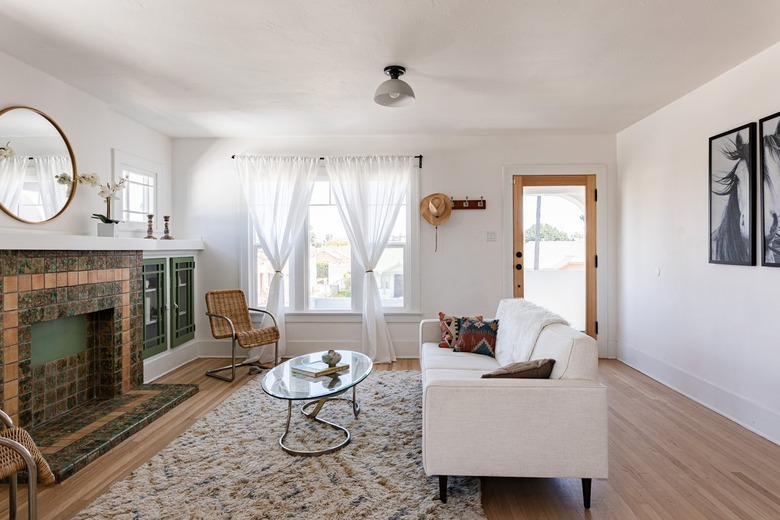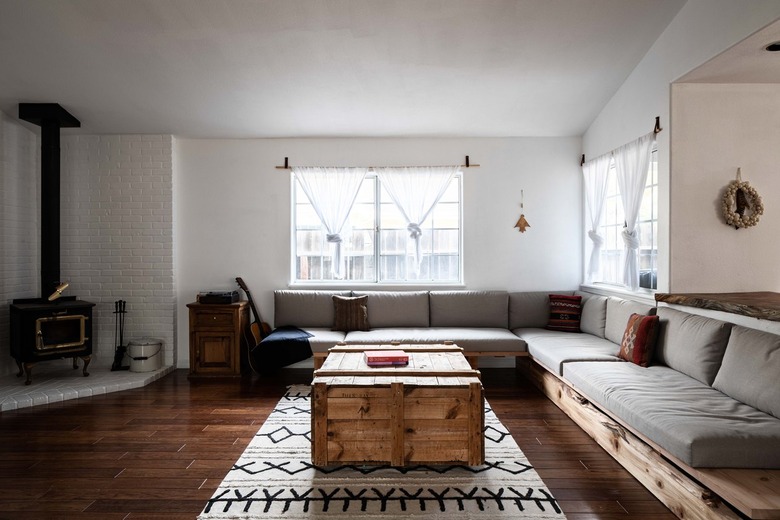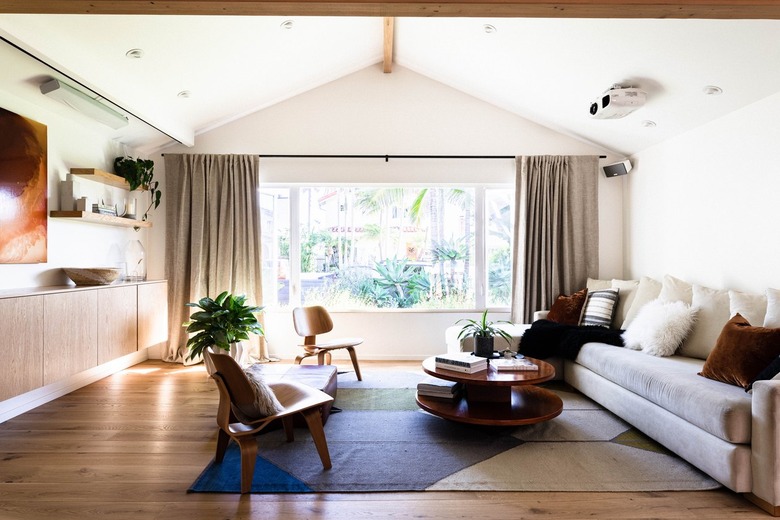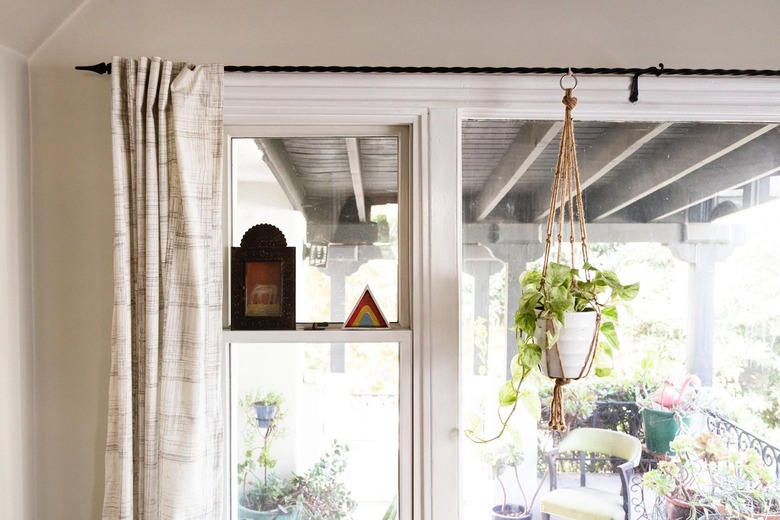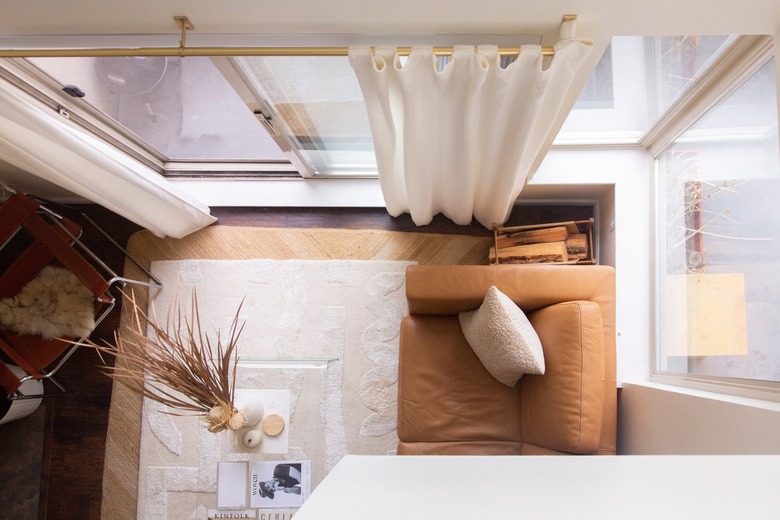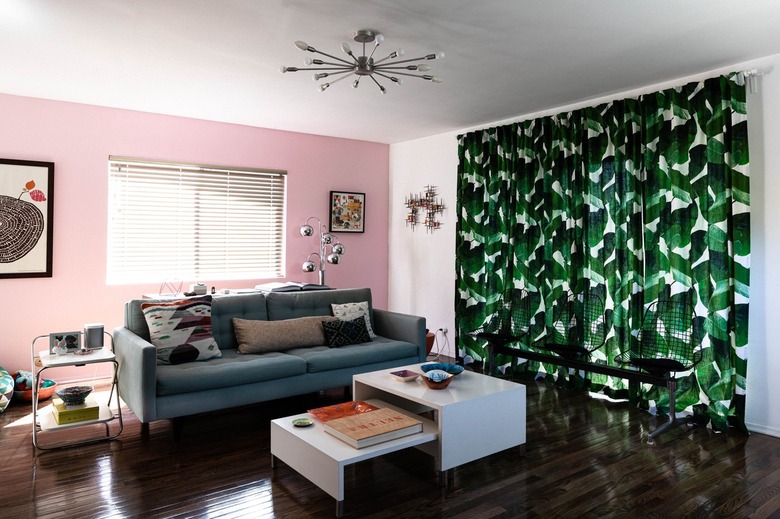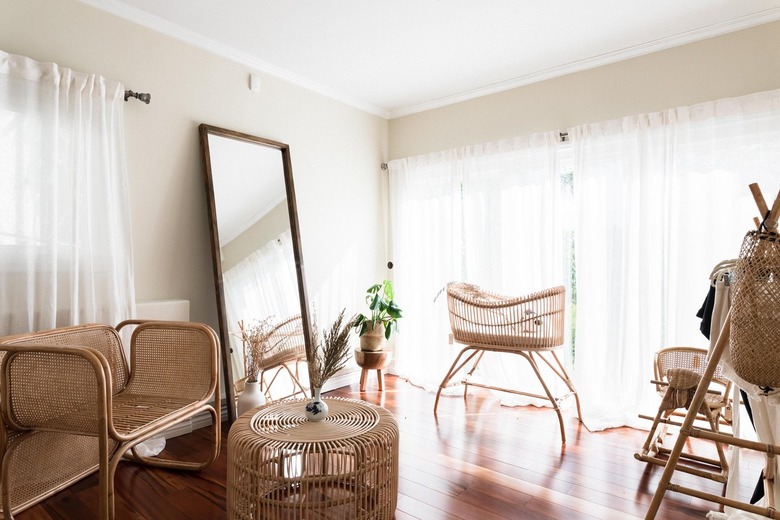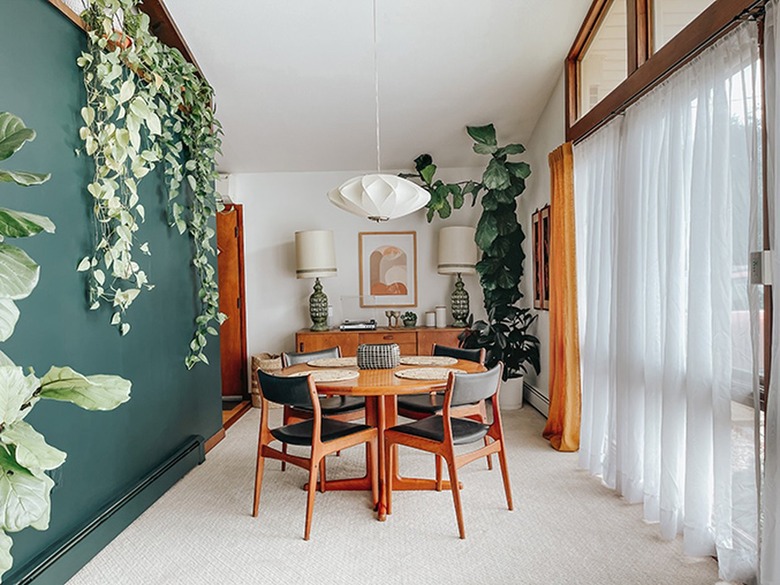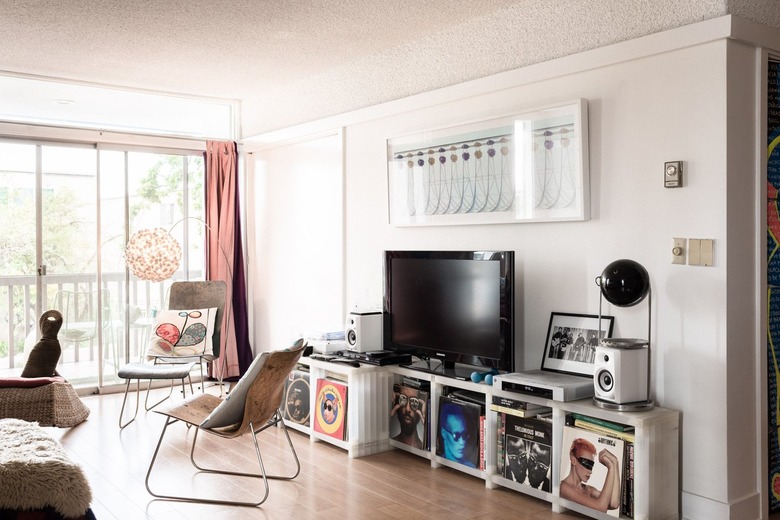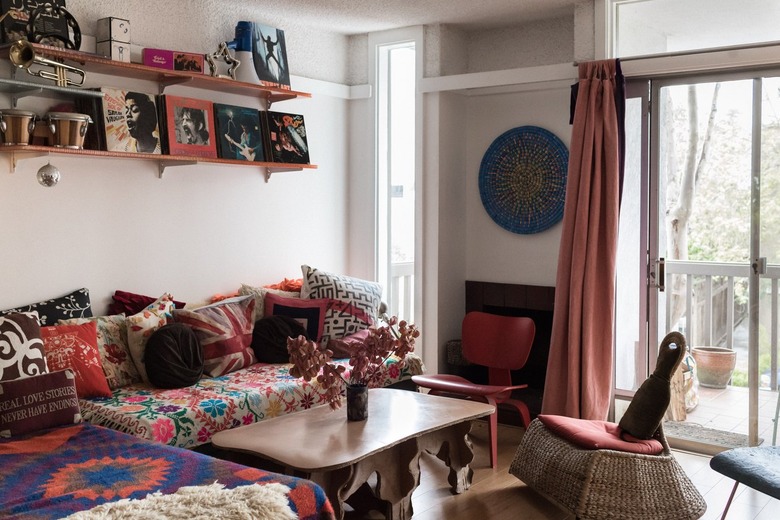10 Things To Consider When Choosing Curtains Or Drapes For Your Living Room
We may receive a commission on purchases made from links.
If the windows are the eyes to the house, then the curtains are the eyebrows — and we all know how important it is to have them styled correctly. Whether you've lived with battered Venetian blinds for years or you simply want to upgrade the curtains in your living room, choosing curtains can be tough. There is a seemingly endless variety of options from which to choose, so it's a good idea to know what you might be looking for before you go shopping.
1. The Curtain's Purpose
1. The Curtain's Purpose
A big part of choosing the right curtains for your living room is knowing what you want them to do. Sheers, for example, are a great way to add a little privacy without blocking a lot of natural light. If you want total privacy, however, you'll have to go with a heavier fabric. How heavy is largely a matter of opinion. If you struggle to watch TV during the day, you may want to go with blackout curtains to eliminate every last bit of glare.
You may also need to take a layered approach. You can use sheers to let some light shine through in the morning but then use a heavier drape curtain panels to block out bright sun later in the afternoon. This can keep out the heat and prevent the sun from fading your furniture.
2. Length and Width
2. Length and Width
When it comes to curtains, size matters. When choosing the width of your curtains, it's a good idea to get curtains that are about 12 inches wider than your window. This accomplishes two important things. For one, it will cover the molding around your window when you close the curtains. Your window won't look right if you can see the molding peeping out from behind a closed curtain.
Extending your curtains a bit also makes for a neater appearance on the curtain rod. Depending on how you hang your curtains, there will likely be 4 to 6 inches of curtain rod sticking out beyond the window. You don't want the curtains to stop before the rod does. A little extra width also creates a nice gathered look when the curtains are open.
Length is just as important as width. In a living room, longer is generally considered more attractive and makes your ceilings look taller, especially if you hang the curtains well above the window frame. You can opt for window curtains that hang just above the floor, touch the floor, or pool dramatically on the floor. Before making your choice, consider your household. If you have kids, pets, or an extremely voracious vacuum cleaner, drapes that puddle on or touch the floor may not work well for you.
Remember to measure all of your windows and take them into account as well. Older houses especially are sometimes a bit uneven, and windows can vary. If you want drapes that will just brush the floor, make sure all of your windows are the same height. If they're not, you may need to make some adjustments to your drapes. Otherwise, one curtain may graze the floor while another stops 3 inches too high.
3. Hardware and Hanging
3. Hardware and Hanging
You have a lot of options when it comes to hanging your drapes, and the choice you make can really change the look and feel of your windows. If you want to the drapes to be the focal point and not the hardware, choose a drapery with a casing at the top. To make a casing, curtain sewers simply fold back the top of the curtain and then sew it in place, making a long tube into which you slide the curtain rod. Think of it like sliding the poles of a dome tent along the proper channel. Some curtains also have tabs hidden behind the drape that accomplish the same task.
If you prefer, you can also choose a curtain with grommets or ring clips. Rings can add some length to the drapes if you need it, and both grommets and ring clips let the curtain rod itself show a bit more and become part of the decor. Ring clips are recommended for drapes you plan to open and close often, as they slide easily across the curtain rod. Make sure you choose ring clips strong enough to support the weight of your curtain fabric, however.
Remember that how you hang curtains gives you a chance to get creative and add a little flair. Sometimes, a unique rod with a funky finial is the perfect way to add some character. For a more subtle approach, consider adding tie-backs to your curtains. These small curtain ideas can make a big difference, especially if the curtains themselves are somewhat subdued.
4. Fabric Choices
4. Fabric Choices
When picking fabric for your curtains, what you can live with may ultimately be more important than what you like. Of course, your personal taste matters, but even if you absolutely love the silk curtains in the store display, will you still love them in a few years after the sun has faded them? This is a known issue with silk draperies, so choose wisely. Silk also gets water spots, which can happen quickly if it rains into an open window.
Any curtains with pleats and swags will need to be dry cleaned, and so will wool, silk, and most sheer curtains given their delicate nature. You can throw cotton, linen, and polyester in the washing machine for an easy clean, so consider them if you want a fabric that's easier to care for. You should wash your curtains twice a year. If you or a family member has allergies, consider linen curtains. You can give them a quick hand wash as often as you need to easily keep down dust and allergens.
5. Choosing a Color
5. Choosing a Color
The color palette for curtains is totally subjective, but it's important to keep a few things in mind before you click "add to cart." If you want your curtains to fade into the background or blend well with the rest of the room, choose muted colors or colors that match your paint and furniture colors. Bolder and more contrasting colors and patterns will stand out more and make a statement, sometimes even anchoring the room.
When choosing your colors, think about more than just design and color theory. You also want to be practical. In a room that gets massive amounts of light, dark colors are much more likely to noticeably fade. Bold colors can also limit future design choices. If you decide to change your living room color scheme in a few years, bright fuchsia drapes may not match your new look, whereas you may be able to repurpose neutral curtains more easily.
6. Lined or Unlined
6. Lined or Unlined
You've made lots of choices already, but now you need to decide if you want your living room curtains lined or unlined. A lining is just a second piece of fabric sewn onto the back of the curtains. Some people like the weight that they add, which makes the curtains hang a little differently.
Curtain lining can solve problems too. Different lining materials can achieve different objectives. Some block a certain amount of light, while others are insulated to keep warm and cool air where you want it. Some are even designed to reduce noise. Lined curtains offer more privacy as well since an opaque liner makes it impossible to see into the room. Depending on the material, unlined drapes are more translucent than opaque and may allow for some visibility.
Lined curtains tend to cost more than unlined curtains, and they can also be substantially heavier. You'll need to make sure your curtain rod is up to the task. Unlined curtains do dry faster after you wash them and add a much lighter, breezy feel to a living room.
7. To Pleat or Not to Pleat
7. To Pleat or Not to Pleat
Before you decide to rule out pleats completely, understand that these aren't your grandmother's pleats. Yes, you can get traditionally pleated curtains if you like the look and feel they offer, but you can also get pleats with a more modern twist. Some companies now make inverted pleat drapes. This design allows you to get the look of pleats in the curtain itself but achieve a smoother finish across the top of the drapes.
Pleats do add a classic and slightly more refined look. They're also a good choice if you need everything in your home a certain way. Pleats hang down on their own and look nice doing it. Less formal unpleated drapes aren't going to work for you if you want them to constantly look perfectly arranged. In that case, opt for the pleats.
8. Adding More Layers
8. Adding More Layers
Layering your drapes is absolutely optional, but it can offer a rich and luxurious look. It also gives you a chance to get creative. Tradition dictates that most drapery layers involve a sheer and a curtain or even a Roman shade and a drape. The limit is really your creativity, however. There is nothing wrong with a colorful sheer rather than a white one. You can also combine multiple colors on the same rod if you want.
Layering also gives you a chance to change things up without breaking the bank. If you can't afford expensive window treatments now, add your layers a bit at a time. Start with sheers or one color of drape. Enjoy them for a while and then use a second rod to add another drape when you can afford to do so. Eventually, you'll have a look you love, but you'll also have curtains to enjoy in the meantime.
9. Your Budget
9. Your Budget
You can get an inexpensive set of curtains that will get the job done without breaking the bank. It's easy to overspend on drapes, however, as there are so many factors that contribute to cost. If you're watching your pennies, you can get curtains for $7 to $20 per panel. If you want something a tad nicer, you can pay $20 to $150 per panel. You can also go with very high-end fabrics for custom curtains for $250 to $1,500 per panel.
The brand, style, fabric, and workmanship all impact the cost of curtains and drapes. Silks and brocades tend to be most expensive, while cotton and polyester can be had for less. Insulated curtains cost more than others, as do lined curtains. Sheers usually cost between $10 and $100 per panel.
Size affects the cost of curtains too. The bigger the panel, the higher the cost. Typically, standard living room panels are about 50 inches wide. They're also 63, 84, or 108 inches long, but some are shorter. If you need larger curtains, you may have to get them custom made, which is quite costly.
10. Customization
10. Customization
Though there's nothing wrong with buying curtains at a home goods store like Target or Walmart, if you're really looking to wrap your windows in perfection, consider a home design company that will send a consultant to you.
You can often take photos of your space and get some help online, but there is nothing like having a live consultant visit your home and get a first-hand look at your space. If you tell your consultant what you're looking for and then show her where it's going to be located, she can often work wonders for you. These experts can help you maximize your budget and get the most enjoyment out of your curtains for many years to come. If you just don't have a designer's touch, consult with someone who does before making an expensive purchase you could regret.
References
- Ballard Designs: Curtain Clips – the Best Way to Hang Your Drapery
- MyDomaine: The Secret to Choosing Curtains to Make Your Room Look More Expensive
- Koikaa: The Difference Between Lined Curtains and Unlined Curtains
- Russells: Fabric Options for Curtains
- Alva: How to Choose Curtains or Drapes for Your Living Room
- Crate & Barrel: Choosing Curtains for Your Windows
- Homedit: How To Pick Living Room Curtains That Perfectly Match Your Style
- CostHelper: Curtains and Drapes Cost
- Elle Decor: 10 Important Things To Consider When You're Buying Curtains
